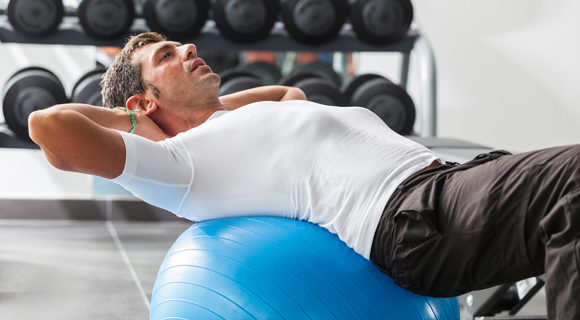
Fitness: Increasing core stability
Increasing your core stability means making the muscles of your trunk stronger to keep your spine and body stable. This helps you stay balanced when you move.
Core stability benefits everyone, from older people to top professional athletes.
How can I increase my core strength and stability?
Core stability exercises are easy to do. It’s more important that you do them well than that you do a lot of them. That’s why it’s a good idea to have a physical therapist check to be sure you have learned to use the right muscles and breathe normally while you do the exercises.
When you do any core stability exercise, it’s important to make sure:
- You are breathing right. When you exercise, you should breathe mostly with your diaphragm, the large muscle that helps move air in and out of your lungs. To learn to breathe with your diaphragm:
- Lie down on your back and put your hand on your stomach.
- When you breathe in and out, your hand should move up and down. Notice how it feels to breathe this way.
- When you start to exercise, try to get the same feeling of your chest and belly moving in and out as you breathe, rather than your chest and shoulders moving up toward your neck and back down.
- You find your neutral spine. Neutral spine is the name for posture that maintains the three normal curves in your spine‚ one in your neck, one in your upper back, and one in your lower back. Your spine should be in this neutral position when you do core stability exercises. It may seem more relaxing to let yourself slump down. But when you lose the normal curves of a neutral spine, you actually put more stress on your body. To find your neutral spine:
- Stand in front of a mirror with your hands on your hips. Allow your low back to arch so your stomach juts forward, and your buttocks stick out. Notice how your hands rotate forward.
- Tighten the muscles around your stomach and buttocks so your low back becomes very flat. Notice how your hands rotate backward.
- Now go halfway between the forward and back positions.
- Keeping your pelvis in this neutral position, stand tall with your ears and shoulders lined up over your hips.
- Practice finding this neutral spine in three positions: standing, sitting, and lying on your back with your knees bent. When you can do that, you can maintain good posture for daily activities and for exercise.
Two simple exercises to try
Pulling your belly in
You can do this exercise anywhere, in any position. Try it while you work at your desk, drive, or stand waiting for your turn at the drugstore.
- Pull in your belly and imagine pulling your belly button back toward your spine. Remember to keep your neutral spine while you do this‚ don’t let your back bend forward.
- Hold this for about 6 seconds. Remember to keep breathing normally.
- Rest for up to 10 seconds.
- Repeat 8 to 12 times.
Floor bridge
- Lie on your back with your knees bent and your feet flat on the floor. Find your neutral spine position, and hold it during the exercise. Pull in your belly, as in the exercise above.
- Push with your feet and raise your buttocks up a few inches.
- Hold about 6 seconds. Remember to breathe normally.
- Lower yourself slowly to the floor and rest for up to 10 seconds.
- Repeat 8 to 12 times.
After you have mastered these simple exercises, your physical therapist can help you find more challenging ways to work on your trunk muscles. For example, you might do some activities while standing up, then do the same activities while sitting on a large ball called a Swiss ball. The ball makes it harder for you to keep your balance as you do the activity.
References
Other Works Consulted
- Dillin W, et al. (2010). Thoracolumbar spine injuries in the adult. In JC DeLee et al., eds., DeLee and Drez’s Orthopaedic Sports Medicine, 3rd ed., vol. 1, pp. 714‚ 753. Philadelphia: Saunders Elsevier.
- Leetun DT, et al. (2004). Core stability measures as risk factors for lower extremity injury in athletes. Medicine and Science in Sports and Exercise, 36(6): 926‚ 934.
- Marshall PW, et al. (2005). Core stability exercises on and off a Swiss ball. Archives of Physical Medicine and Rehabilitation, 86(2): 242‚ 249.
- Negrini S, et al. (2010). Rehabilitation of lumbar spine disorders: An evidence-based clinical practice approach. In WR Frontera et al., eds., DeLisa’s Physical Medicine and Rehabilitation: Principles and Practice, 5th ed., vol. 1, pp. 837‚ 882. Philadelphia: Lippincott Williams and Wilkins.
Current as of: November 14, 2014
Author: Healthwise Staff
Medical Review: Adam Husney, MD – Family Medicine & Joan Rigg, PT, OCS – Physical Therapy
This information does not replace the advice of a doctor. Healthwise, Incorporated disclaims any warranty or liability for your use of this information. Your use of this information means that you agree to the Terms of Use. How this information was developed to help you make better health decisions.
To learn more, visit Healthwise.org
© 1995-2015 Healthwise, Incorporated. Healthwise, Healthwise for every health decision, and the Healthwise logo are trademarks of Healthwise, Incorporated.
The Health Encyclopedia contains general health information. Not all treatments or services described are covered benefits for Kaiser Permanente members or offered as services by Kaiser Permanente. For a list of covered benefits, please refer to your Evidence of Coverage or Summary Plan Description. For recommended treatments, please consult with your health care provider.
TOPICSSports & Fitness





